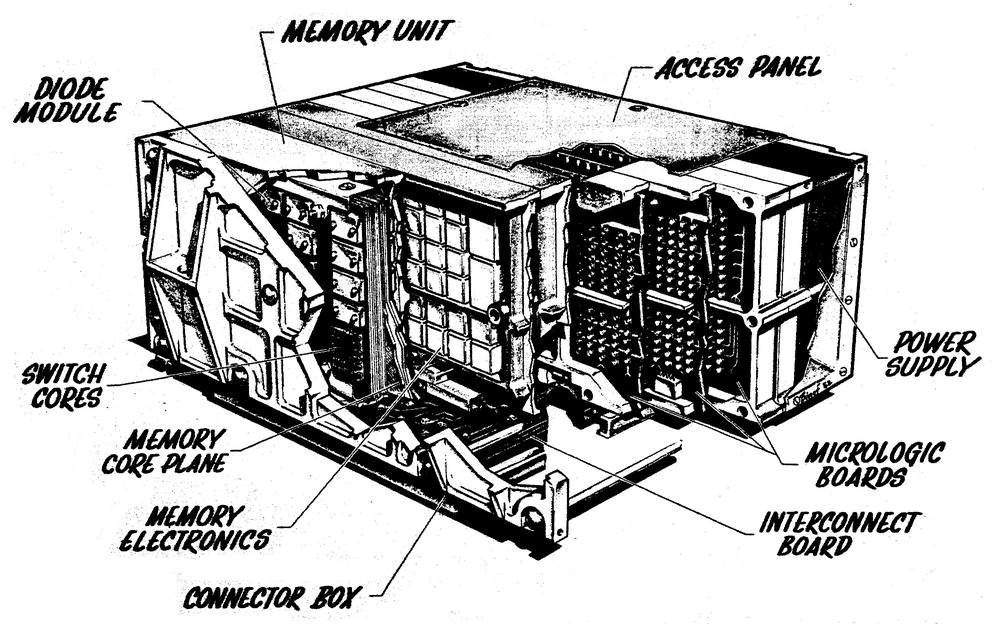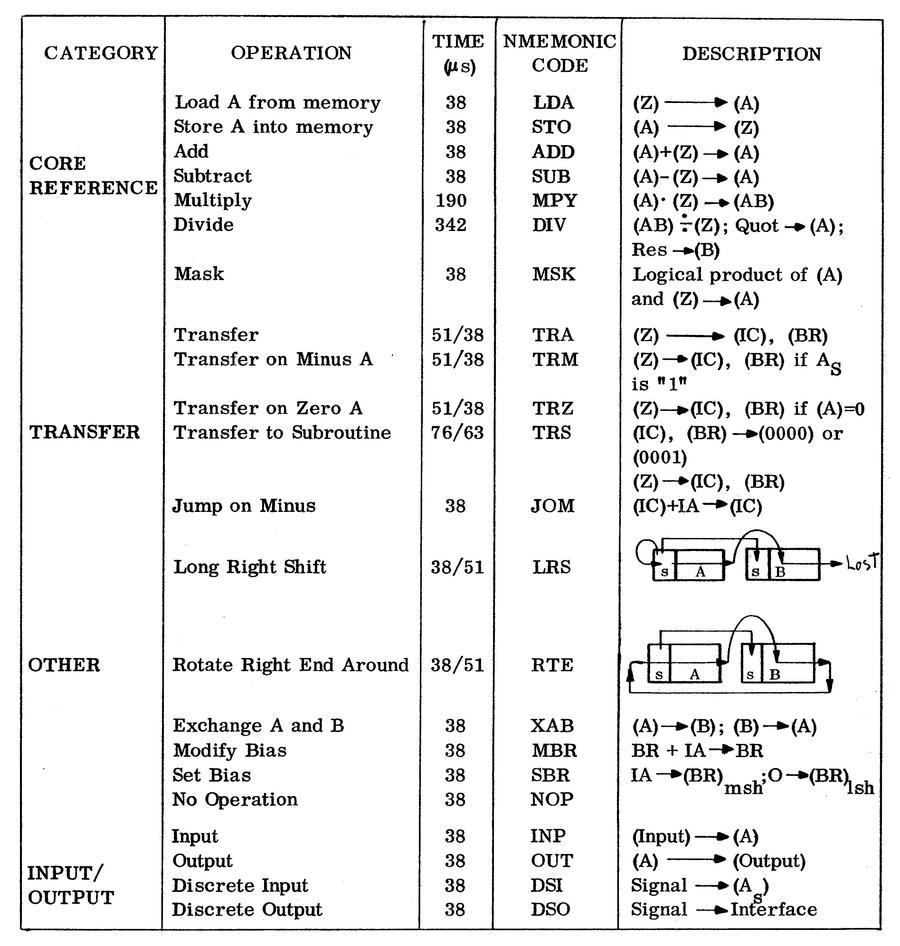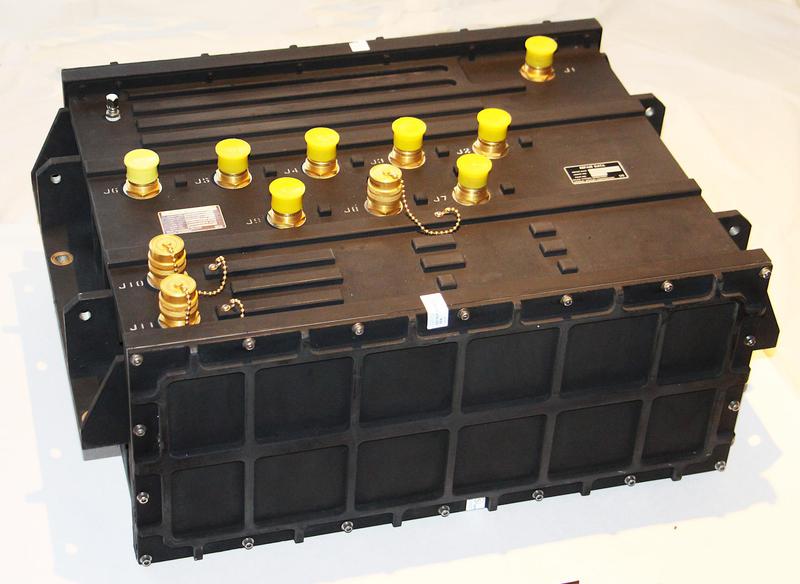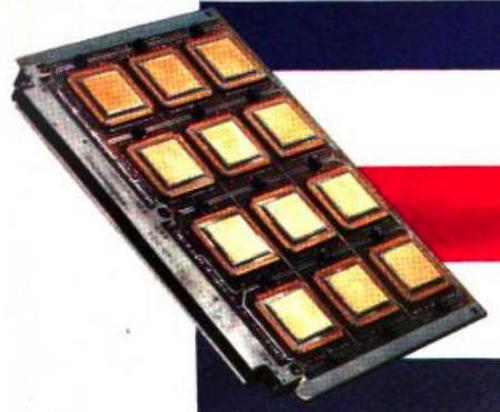This post is a summary of the Magic line of computers, produced by Delco / General Motors from 1962 to the 1980s. These computers were developed for navigation, guidance, and control of rockets, missiles, and aircraft. I couldn't find a good summary of all the Magic computers, so I've collected information from various sources here. This article probably isn't of interest to most people as it's more of a footnote that grew out of control but I'm putting it here for reference.
MAGIC I
MAGIC I (1961-1963) was designed for ballistic missile guidance and was the "first complete airborne computer to have its logic functions mechanized exclusively with integrated circuits". It used 2,098 Fairchild Micrologic integrated circuits, the first commercial IC family. These integrated circuits were very simple, such as a three-input NOR gate, a flip flop, or a half adder. MAGIC I was a compact computer weighing about 35 pounds with a volume of .64 cubic feet. It used 90 watts of power. It was a serial computer, operating on one bit at a time, which made it slow but reduced the hardware requirements. It used 24-bit words, as they determined that 24 bits provided sufficient accuracy. It had 4K words of core memory storage. Instructions were 12 bits, with two instructions per word. An addition operation took 70µs.
MAGIC II
MAGIC II (1965) was a serial 24-bit computer used in the P-3A and F-8 aircraft. It weighed 35 pounds, had a volume of 0.5 cubic feet, and used 90 watts. Storage was 4K words of ROM and 256 words of magnetic core. It was constructed from about 1300 simple integrated circuits: buffers, counter adapters, double gates, half adders, and half shift. It took 38µs to add. Its simple instruction set (below) had 22 instructions. Like the MAGIC I, instructions were 12 bits, with two instructions per word.
Magic III
Magic III (1963-) was a family ranging from simple serial computers to high-performance parallel computers. (The Magic name appears to have lost the all-caps starting with Magic III.) These computers covered a wide variety of architectures, word sizes, and instruction sets. They ranged from slow serial computers that processed one bit at a time to parallel computers that processed a word at a time (as most computers do, not to be confused with parallel processing).
Magic 301 (1963, serial, 16-bit), It was used in the KT-70 missile guidance system in the P-3C, A-7, and F-105 aircraft, as well as the L-1011 guidance system and the SRAM nuclear short-range attack missile. It weighed 5.2 pounds, was 0.1 cubic feet, and used 39 watts. Addition took 24µs. The computer was very compact: 4.9"×3.2"×8.8". It had 1792 8-bit words, expandable to 2048 words. Instructions were 8 bits while data words were 16 bits.
Magic 311 (1967, serial, 12-bit instructions, 24-bit data with two parity bits): It had core memory holding 6144 words of 12 bits plus parity. (It could be manufactured with ROM memory by omitting cores in the core memory to represent 0 bits.) Its instruction set had 14 instructions and it took 19.5 us to perform an add. It was used in the Delco Carousel IV inertial measurement unit (IMU) used on the 707 and 747 aircraft. The computer was 0.44 cubic feet, weighed 22 pounds and used 110 watts. Its addition time was 19.5µs.
Magic 321 (serial, 15-bit instructions, 31-bit data plus parity). It had 4K blocks of core up to 32K and ran with a 3.072 MHz clock. It had 22 instructions in its instruction set and weighed 23 pounds.
Magic 331 (parallel, 31-bit plus parity) used 15-bit instruction. It had a 1 MHz clock and up to 32K memory. It had 23 instructions in its instruction set and weighed 23 pounds. 670 of these computers were built.
The Magic 341 (1971) was a 16-bit computer, built from MOS integrated circuits. It was considered for the Space Shuttle, which ended up using IBM's AP-101 computer instead. It had 2K to 64K words of magnetic core or MOS memory. It was used in the HH-60 helicopter. It had weighed 10 pounds a volume of .12 cubic feet (4"×7"×15") and took 5µs for an addition. It had 16 instructions in its instruction set.
The Magic 351 (1970) was a 19-bit computer using MSI TTL, with 24 bits as an option. It weighed 22 pounds, was 0.42 cubic feet, and used 120 watts. It was used in the C-5B cargo plane. It had 61 instructions in its instruction set.
The Magic 352 (early 1970s) had 24-bit words (plus a parity bit), with a 16 kiloword core memory. It had 57 instructions and did an add/subtract in 6 microseconds (details). It had six index registers. The Carousel IV and Magic 351 computer were turned into a military navigation system called the Carousel V, using the Magic 352 missile guidance computer (MGC) (the computer in this blog post). For space use, this system was called the Universal Space Guidance System (USGS), and the Titan IIIC rocket switched from Univac to the USGS, first flying on December 13, 1973 (details). After its use on the Titan III, the USGS system was retrofitted onto Titan II missile, replacing the ASC-15 (details), in a project was called RIVET HAWK (1975-1976).
The Magic 362 was used in Navy ATIGS and the F-16 fire control computer (FCC). It had 32K×16 bit semiconductor memory (24K ROM, 8k RAM). The Magic 362 and later computers supported the 16-bit MIL-STD-1750A instruction set; to reduce costs and complexity, the military standardized on this instruction set from 1980 to 1996. This instruction set (described here) is fairly extensive, with many addressing modes and floating-point support.
Magic 372 (1982) performed 666 KIPS (thousand instructions per second). It was implemented from Am2901 bit slices along with SSI and MSI chips. It was used in F-16 C/D and LANTIRN.
Magic IV
The Magic IV series was introduced around 1974, switching to an all-LSI design. It used 32K×16 bit semiconductor memory and took a 28VDC power supply It was used in the KC-135 tanker.
Magic V
The Magic V series was introduced around 1982, using a VLSI design that put the computer on 12 chips on a single board. The M572 was an extension of the M372. It had a 16-bit design and 192K of RAM, using under 5 watts. It was used on the C-17A cargo airplane for the mission computer and displays.
Notes
Some references on the Magic family are here, here, here, here, here, and here.
It's difficult to sort out the permutations of Delco, AC Spark Plug, AC Electronics, AC Delco, and so forth. AC Spark Plug started in 1908 and became a division of General Motors in 1927. It was named after Albert Champion who also started Champion spark plugs. AC Spark Plug's Milwaukee manufacturing facility became AC Electronics in 1965, with a focus on inertial navigation (details). Meanwhile, Dayton Engineering Laboratories (Delco) was founded in 1909, and acquired by General Motors in 1918. GM's defense systems laboratory was started in 1962 and merged into Delco Systems Operations in Goleta (where this Titan guidance computer was built). In 1970, the Delco Radio Division and AC Electronics Division of General Motors Corporation were consolidated into a new Delco Electronics Division. In 1985, GM purchased Hughes Aircraft and merged it with Delco to form Hughes Electronics, which was sold to Raytheon in 1997.




10 comments:
I went to A&P school in the late 1990s and we had a Carousel IV originally out of an airliner that later was in a Beech King Air used for aerial photo mapping. Quite a piece of equipment.
Note on aircraft designations: between the letters at the beginning ("A", "C", "F", "P") and the number, there's a dash. This applies to all designations in the Post-1963 designation system, which is all the aircraft listed in this post. So it should read: "A-7", "C-17A"
666 KIPS. Hmmmm. The Apple-1 sold for $666. Coincidence? ;-)
You are so right about aerospace computers being left out of the mainstream histories. I wonder whether this is due to security rules--do the computers you've looked at (or their documentation) include any indication of classification levels? Or declassification dates? It would seem unsurprising for a missile guidance computer to be highly classified.
Wow - multiply & divide instructions seem pretty advanced for the mid-60's.
Not really -- the CDC Cyber we had at college had hardware floating point multiply and divide, and this was 1974. It was just expensive in terms of logic. If you cold afford the logic, you could have it.
Even the PDP-8 (1965) had multiply and divide:
https://en.wikipedia.org/wiki/PDP-8#Basic_instructions
Hi, you say the MAGIC II was used in F-8 (Crusader). From what I know, F-8 was a pure analog fighter, except NASA experiments (one with FBW, from memory). Could you develop about F-8 and MAGIC II ? Congratulations for an amazing work.
Nice article... I'd be interested to see your comments on the NAA/Autonetics VERDAN flight computer, and it's Marine (SINSS) and later (MARDAN) cousins, including the early ancestor in the HoundDog cruise missile.
Maybe confusion with the Magic 2 missile that was used with the F-8 Crusader by the French?
Around 1978, I worked at the Delco Electronics plant on Hollister west of Storke Road in Goleta, California, manufacturing heavy aluminum boxes like the one shown in the first image. I was told the boxes held "the Titan IMU" (most people still had clear memories of Gemini in those days, so "Titan" didn't require explaining). From your post I deduce that I must have been working on RIVET HAWK, maybe late in the program manufacturing the spares or the like. I was not an engineer at the time, so I have little to add technically except a few odd reflections...one of the manufacturing steps for those boards was to wash them in a dishwasher, an ordinary commercial dishwasher that was installed on the manufacturing floor. And the manufacturing process for the heavy aluminum boxes was the most incredible scut-work: the boxes were "screwed and glued" with some type of metal adhesive, and the metal had to be clean, chemically clean. So each panel of the box was attached to a hoist and then sequentially dipped, first in a vat of hot dilute acid, then in a series of vats of nasty solvents. Anyway, thanks for the nostalgia trip and the brilliant work on this blog.
Post a Comment